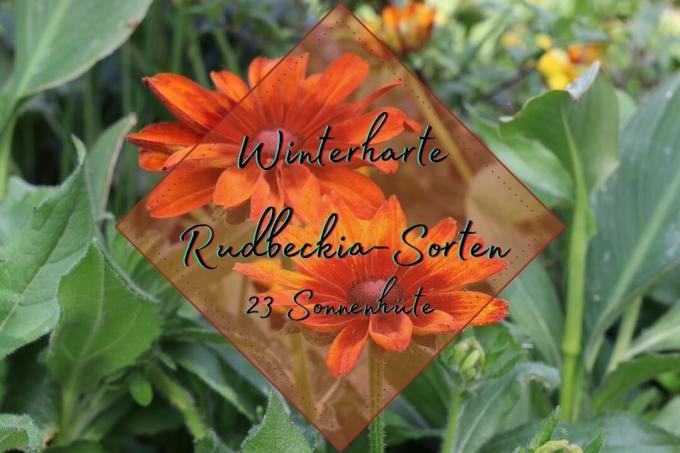
table of contents
- Beauty from North America
- Popular rudbeckia varieties
- Hardy Rubeckia
- Cold-resistant rudbeckia varieties
- Undemanding Rubeckien
- frequently asked Questions
Sun hats (rudbeckia) are popular perennials that add bright accents to every flower bed in autumn. They are undemanding, easy to care for and hardy. Due to the large variety of varieties, there is something for every garden.
In a nutshell
- coming from North America
- love sun
- mostly hardy
- some need winter protection
- many varieties arose through breeding
Beauty from North America
The home of these distinctive sun hats is North America. There they grow in a wide variety of areas such as savannahs, on damp meadows or at altitudes of up to 2,800 meters. Some of them are annual or biennial, but are usually perennial and hardy plants. In this country, too, they adorn many gardens from midsummer to autumn. They are mainly cultivated as ornamental plants. There are also grateful cut flowers that last a long time in the vase. Sun hats in the garden are a real paradise for bees and butterflies. Rudbeckia are quite undemanding, but there are still a few things to consider:
- Location: sunny to partially shaded, warm, sheltered from the wind
- Soil: well drained, rich in humus and nutrients, moist

Note: Rudbeckia are excellent for ins Perennial bed integrate. They thrive next to scented nettles, ornamental grasses, echinacea, zinnias and monkshood. The sun hats also cut a good figure directly on the edge of a wood.
Popular rudbeckia varieties
The rudbeckia genus includes over 20 different species. Already in the 17th In the 19th century, individual varieties were cultivated as ornamental plants in France and England. In the meantime, countless other varieties have been created through continuous breeding. Below is a list of the most popular varieties.
Rudbeckia fulgida "City Garden"
- Height: 30 to 40 cm
- Flowers: diameter 25 mm, radial, deep yellow with dark brown eye
- Flowering period: July to October
- Plant spacing: 30 to 40 cm, 5 pieces per m²
- Winter hardiness: -23.4 ° C to -17.8 ° C (zone 6)
Rudbeckia fulgida "Early Bird Gold"
- Synonym: Magnificent sun hat "Early Bird Gold"
- Height: 50 to 60 cm
- Flowers: radial, very profuse, dark yellow with deep black eyes
- Flowering period: July to October / November
- Plant spacing: 50 to 60 cm, 3 to 4 pieces per m²
- Winter hardiness: -23.4 ° C to -17.8 ° C (zone 6)
Note: This variety is ideal for growing in a bucket.
Rudbeckia fulgida var. deamii
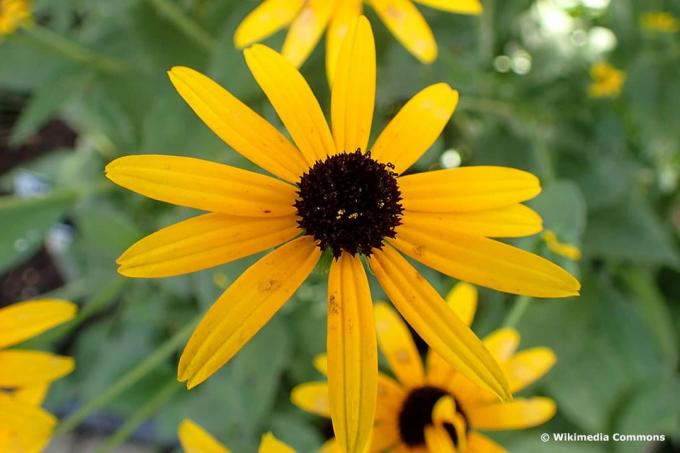
- Synonym: Deams sun hat
- Height: 80 to 100 cm
- Flowers: cup-like, golden yellow with a black center
- Flowering period: August to September
- Plant spacing: 60 cm, 2 pieces per m²
- Winter hardiness: -34.5 ° C to - 28.9 ° C (Zone 4)
Rudbeckia fulgida var. speciosa

- Height: 50 to 100 cm
- Flowers: simple, bowl-shaped, 5 to 10 cm in diameter, golden yellow with a dark brown to black center
- Flowering period: July to September / October
- Plant spacing: 60 to 80 cm, 2 to 3 pieces per m²
- Winter hardiness: -34.5 ° C to -28.9 ° C (Zone 4)
Rudbeckia fulgida var. sullivantii "gold storm"
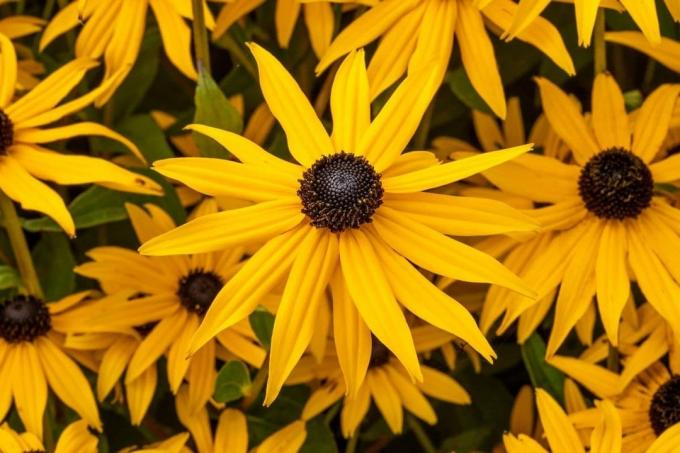
- Synonym: Magnificent sun hat "Goldsturm"
- Height: 60 to 80 cm
- Flowers: 5 to 10 cm in diameter, simple, cup-like, golden yellow, black eye
- Flowering period: August to October
- Plant spacing: 40 to 60 cm, 3 to 4 pieces per m²
- Winter hardiness: -34.5 ° C to -28.9 ° C (Zone 4)
Note: This variety also grows well in partial shade. It is also a popular dried flower.
Hardy Rubeckia
Rudbeckia fulgida var. sullivantii "Little Goldstar"
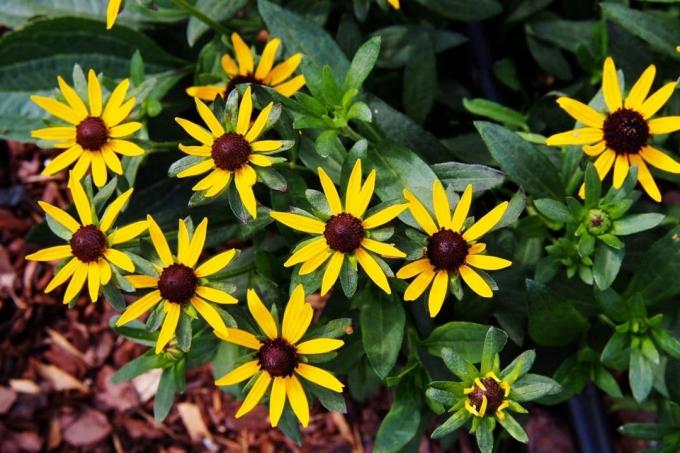
- Synonym: Magnificent sun hat "Little Goldstar"
- Height: 40 to 50 cm
- Flowers: plate-shaped, bright golden yellow with a large, round and black center
- Flowering period: August to October
- Plant spacing: 40 cm, 4 to 6 pieces per m²
- Winter hardiness: -34.5 ° C to -28.9 ° C (Zone 4)
Note: Do not prune back after flowering, the seeds in the dark center are good winter fodder for wild birds.
Rudbeckia hirta "Autumn Colors"

- Height: 50 to 60 cm
- Flowers: simple, cup-like, diameter 15 cm, brown eye, orange, red or brown shades
- Flowering period: July to October
- Plant spacing: 30 to 40 cm, 5 pieces per m²
- Winter hardiness: conditionally hardy, tolerates frost down to -7 ° C, winter protection necessary
Rudbeckia hirta "Cherry Brandy"
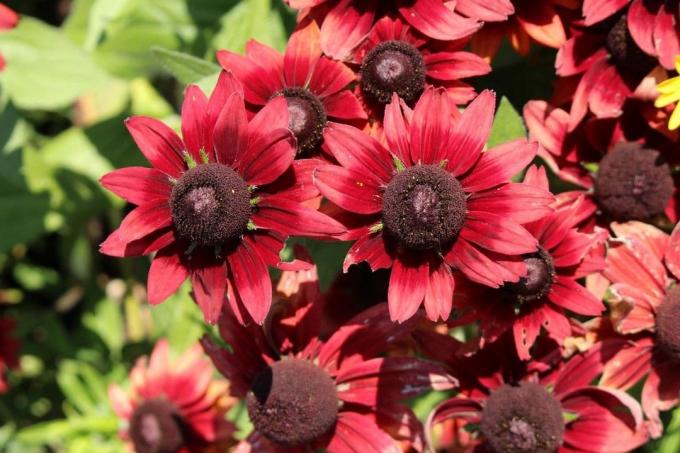
- Synonym: Rough sun hat "Cherry Brandy"
- Height: 60 cm
- Flowers: large, dark brown and arched flower base, flower color cherry red to dark red
- Flowering period: June to October
- Plant spacing: 30 to 40 cm, 8 pieces per m²
- Winter hardiness: tolerates frost down to -7 ° C, winter protection appropriate
Rudbeckia hirta "Kissing Smiley"
- Height: 50 to 70 cm
- Flowers: diameter 10 to 15 cm, velvety basket blossom, coloring brown-red, red, yellow, red-brown eye
- Flowering period: June to October
- Plant spacing: 40 to 50 cm, 7 pieces per m²
- Winter hardiness: tolerates frost down to -10 ° C, winter protection appropriate
Rudbeckia hirta "Prairie Sun"

- Height: 60 to 100 cm
- Flowers: wheel-shaped inflorescences, arranged in racemes, orange-yellow with a brown center
- Flowering period: May to September
- Plant spacing: 60 to 80 cm, 3 pieces per m²
- Winter hardiness: tolerate frost down to -10 ° C, light winter protection necessary
Rudbeckia laciniata "Goldball"
- Synonym: Filled sun hat "gold ball"
- Height: 180 to 200 cm
- Flowers: double, ball-like, golden yellow
- Flowering period: August to October
- Plant spacing: 90 cm, 1 plant per m²
- Winter hardiness: -40.1 ° C to -34.5 ° C (Zone3)
Note: The new shoot must be protected from snails.
Cold-resistant rudbeckia varieties
Rudbeckia laciniata "Goldquelle"

- Synonym: Filled sun hat "Goldquelle"
- Height: 70 to 80 cm
- Flowers: large, pompom-like, double, lemon yellow
- Flowering period: July to September
- Plant spacing: 60 cm, 2 pieces per m²
- Winter hardiness: -40.1 ° C to -34.5 ° C (Zone 3)
Rudbeckia maxima
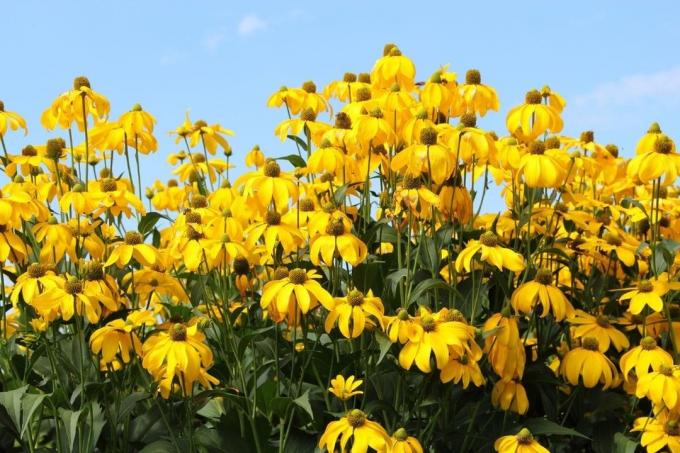
- Synonym: giant sun hat
- Height: 200 to 300 cm
- Flowers: cup-shaped, pendent ray-flowers, yellow, in the middle initially green, later brown cone
- Flowering period: August to September
- Plant spacing: 70 cm, 2 pieces per m²
- Winter hardiness: -23.4 ° C to -17.8 ° C (zone 6)
Rudbeckia missouriensis

- Synonym: Missouri sun hat
- Height: 40 cm
- Flowers: umbrella-like, bright yellow with black eye
- Flowering period: July to September
- Plant spacing: 50 cm, 4 pieces per m²
- Winter hardiness: -28.8 ° C to -23.4 ° C (Zone 5)
Rudbeckia nitida "Herbstsonne"

- Synonym: parachute sun hat "autumn sun"
- Height: 150 to 200 cm
- Flowers: large, radial, slightly pendulous ray-flowers, lemon-yellow, greenish-brown and conical center
- Flowering period: August to September
- Plant spacing: 80 cm, m² 1 to 3 pieces
- Winter hardiness: -40.1 ° C to -34.5 ° C (Zone 3)
Rudbeckia nitida "Juligold"
- Synonym: Parachute sun hat "Juligold"
- Height: 150 to 200 cm
- Flowers: umbrella-like, golden yellow, greenish center
- Flowering period: July to August
- Plant spacing: 80 to 90 cm, 1 to 2 pieces per m²
- Winter hardiness: -40.1 ° C to - 34.5 ° C (zone 3)
Rudbeckia occidentalis "Green Wizard"

- Synonym: Western sun hat "Green Wizard"
- Height: 100 cm
- Flowers: no ray-flowers present, columnar, black-brown heads surrounded by green bracts
- Flowering period: July to October
- Plant spacing: 50 cm, 4 pieces per m²
- Winter hardiness: -23.4 ° C to -17.8 ° C (zone 6)
Rudbeckia subtomentosa "Henry Eilers"
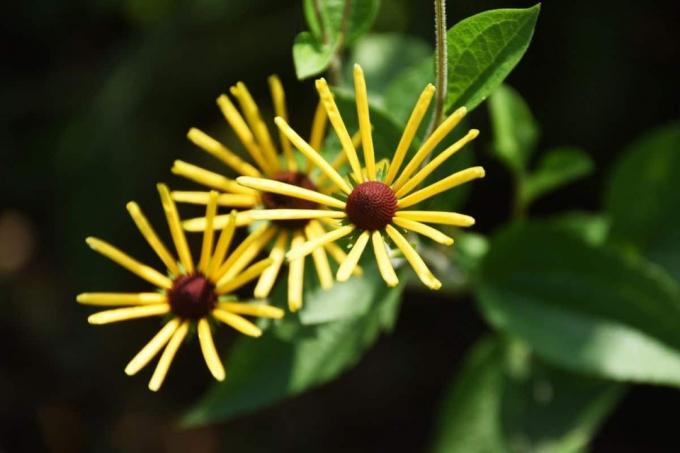
- Synonym: Black felted sun hat "Henry Eilers"
- Height: 100 to 150 cm
- Flowers: plate-shaped, strong yellow tubular flowers ending in small, broad tongues, dark brown, convex center
- Flowering period: July to September
- Plant spacing: 50 cm, 3 pieces per m²
- Winter hardiness: -28.8 ° C to -23.4 ° C (Zone 5)
Undemanding Rubeckien
Rudbeckia subtomentosa "Little Henry"
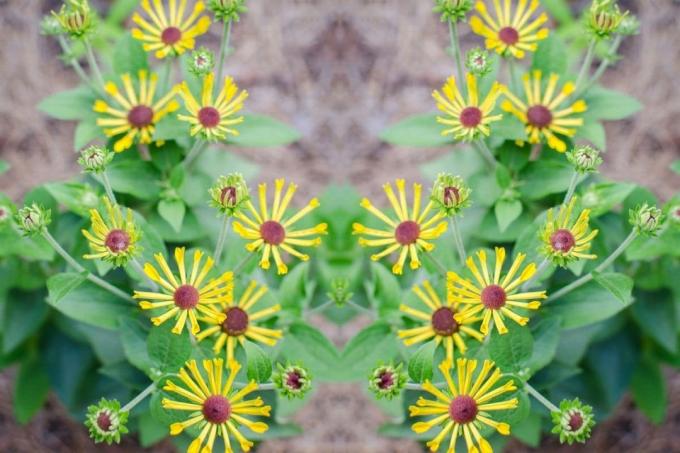
- Synonym: Black felted sun hat "Little Henry"
- Height: 80 cm
- Flowers: cup-like, yellow, dark brown eye
- Flowering period: July to September
- Plant spacing: 40 to 50 cm, 1 to 3 pieces per m²
- Winter hardiness: -28.8 ° C to - 23.4 ° C (Zone 5)
Rudbeckia subtomentosa "Loofahsa Wheaten Gold"
- Height: 140 to 150 cm
- Flowers: large, yellow ray-flowers, black-brown center
- Flowering period: July to September / October
- Plant spacing: 80 cm, 1 to 2 pieces per m²
- Winter hardiness: -28.8 ° C to - 23.4 ° C (Zone 5)
Rudbeckia triloba
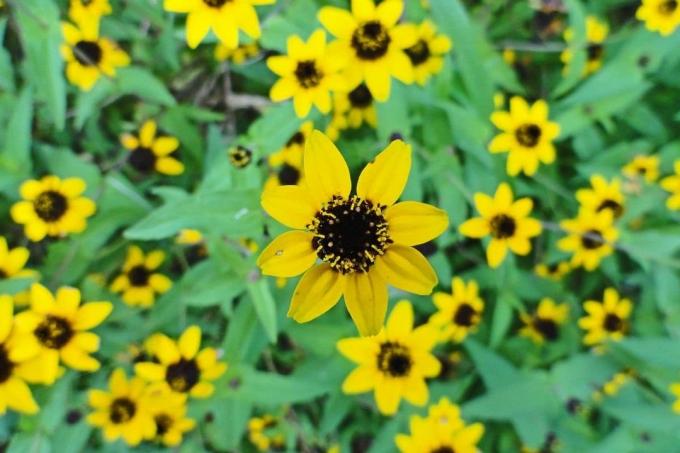
- Synonym: October sun hat
- Height: 100 to 120 cm
- Flowers: cup-like, deep yellow, black eye
- Flowering period: August to October
- Plant spacing: 60 cm, 2 pieces per m²
- Winter hardiness: -28.8 ° C to -23.4 ° C (Zone 5)
Rudbeckia triloba "Blackjack Gold"
- Synonym: October sun hat "Blackjack Gold"
- Height: 100 cm
- Flowers: round, large, golden yellow with black eye
- Flowering period: August to October
- Plant spacing: 60 cm, 2 pieces per m²
- Winter hardiness: -28.8 ° C to -23.4 ° C (Zone 5)
Note: This variety shows good drought resistance.
Rudbeckia triloba "Prairie Glow"
- Synonym: October sun hat "Prairie Glow"
- Height: 100 to 120 cm
- Flowers: simple, plate-shaped, yellowish-red with black eye during flowering, bronze-colored to deep red when blooming
- Flowering period: July to September / October
- Plant spacing: 60 cm, 2 pieces per m²
- Winter hardiness: -28.8 ° C to - 23.4 ° C (zone 5)
frequently asked Questions
Both perennials are called coneflowers. However, due to botanical differences, they belong to two different plant genera. You can easily distinguish the plants on the flower base of the respective flower. In the Rudbeckia it is arched, smooth and soft and in the Echinacea it is prickly.
Usually these colorful perennials are quite undemanding. Once they're in, not much maintenance is required. Regular watering is required in very hot dry periods. Furthermore, the soil should be loosened up a little at intervals and an organic fertilizer is appropriate in the spring. In addition, withered flowers should always be removed, this stimulates renewed flower formation.
The most common method is division in the fall after flowering. However, the plant should only be divided every three to four years. In addition, sowing in April / May directly outdoors or in pots is possible. Furthermore, cuttings can be propagated. To do this, a cutting with at least three pairs of leaves is placed three centimeters deep in a pot of potting soil and kept moderately moist.



